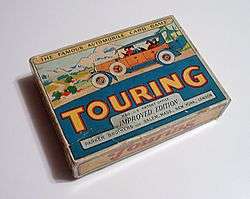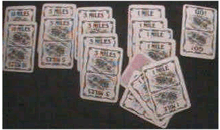Touring (card game)
Touring is a specialty card game originally designed by William Janson Roche[1] and patented by the Wallie Dorr Company and produced in 1906. It was acquired by Parker Brothers in 1925.[1][2]
 1926 Parker Bros improved edition | |
| Manufacturer(s) | Parker Bros |
|---|---|
| Designer(s) | Wallie Dorr Co |
| Publisher(s) | Winning Moves, Parker Bros |
| Publication date | 1906 |
| Years active | 1906–1976 |
| Genre(s) | Take That |
| Language(s) | English |
| Players | 2, 3, 4 and 6 |
| Skill(s) required | Medium |
| Media type | Cards |
It is widely believed the popular French card game Mille Bornes was derived from Touring. After several revisions, Touring was discontinued shortly after Parker Brothers picked up the American license of Mille Bornes.[1][2] However, the game of Touring was reissued by Winning Moves in 2014.
Updates to editions
The original Wallie Dorr edition was a small red box with 100 cards. They updated the game to a side-by-side wider box which Parker Bros used for their first edition of the game after they purchased it.
Periodically the Parker Bros. Co. adjusted the card art and subsequently, the images became more modern, and increased the mileage cards. Until the final edition, game play remained unchanged, just the denominations of miles increased as the trip length and comfort of automobile travel increased. The final edition reversed the trend, using artwork closer to the original Model-T-era cars and adjusting the card totals with an addition of two new delays.
Original rules

.jpg)
The players run a race of 50 or 100 miles, as agreed before the game starts. A player cannot play the mileage cards (1, 3, 5, 10 Miles) unless they have a Go card in front of them. If both players are in City Limits (played by either), they can't play the 10 Mile card ("Speed Limit 5 Miles per Hour"); they can remove this card's effect by playing the Country! card (which affects both players). They lose 1 or 2 hours if an opponent plays a Collision ("Delay! 1 Hour"), Out of Gasoline ("Delay! 1 Hour"), or Puncture ("Delay! 2 Hours") card and must discard an "hour's" worth of cards for each hour (5 miles in the city, 10 miles in the country). To resume driving, they must also play a "Remedy" card (Hauled In for a collision and Gasoline for Out of Gasoline, nothing for Puncture) and a Go card. To win, the player must exactly match the total mileage (50 or 100 miles, as agreed).[3]
Play variant
In each copy of the directions were an option to play progressive touring, in which multiple tables of 4 would play simultaneously.
Cards of select editions
| Type of card | Year of issue | Count | Denomination | Change from previous |
|---|---|---|---|---|
| Mileage | 1906 | 20 | 1 Mile | n/a |
| Mileage | 1906 | 10 | 3 Miles | n/a |
| Mileage | 1906 | 10 | 5 Miles | n/a |
| Mileage | 1906 | 12 | 10 Miles | n/a |
| Delay | 1906 | 3 | Collision | n/a |
| Delay | 1906 | 3 | Out of gasoline | n/a |
| Delay | 1906 | 2 | Puncture | n/a |
| Remedy | 1906 | 8 | Hauled in | n/a |
| Remedy | 1906 | 8 | Gasoline | n/a |
| Movement | 1906 | 15 | Go | n/a |
| Movement | 1906 | 4 | City Limits | n/a |
| Movement | 1906 | 5 | Country | n/a |
| Mileage | 1937 | 19 | 1 Mile | 1c fewer |
| Mileage | 1937 | 10 | 3 Miles | n/c |
| Mileage | 1937 | 10 | 15 Miles | 10 mi more than 1906 |
| Mileage | 1937 | 12 | 30 Miles | 20 mi more than 1906 |
| Delay | 1937 | 3 | Collision | n/c |
| Delay | 1937 | 3 | Out of gas | n/c |
| Delay | 1937 | 2 | Puncture | n/c |
| Remedy | 1937 | 8 | Hauled in | n/c |
| Remedy | 1937 | 8 | Gasoline | n/c |
| Movement | 1937 | 15 | Go | n/c |
| Movement | 1937 | 4 | City limits | n/c |
| Movement | 1937 | 5 | Country | n/c |
| Mileage | 1957 | 19 | 5 Mile | 4 mi more than 1937 |
| Mileage | 1957 | 10 | 15 Miles | 12 mi more than 1937 |
| Mileage | 1957 | 10 | 25 Miles | 10 mi more than 1937 |
| Mileage | 1957 | 12 | 45 Miles | 15 mi more than 1937 |
| Delay | 1957 | 3 | Collision | n/c |
| Delay | 1957 | 3 | Out of gasoline | n/c |
| Delay | 1957 | 2 | Puncture | n/c |
| Remedy | 1957 | 8 | Hauled in | n/c |
| Remedy | 1957 | 8 | Gasoline | n/c |
| Movement | 1957 | 15 | Go | n/c |
| Movement | 1957 | 4 | City limits | n/c |
| Movement | 1957 | 5 | Country | n/c |
| Mileage | 1965 | 19 | 25 miles | 24 mi more than 1937 |
| Mileage | 1965 | 10 | 35 miles | 32 mi more than 1937 |
| Mileage | 1965 | 10 | 50 miles | 35 mi more than 1937 |
| Mileage | 1965 | 12 | 75 miles | 45 mi more than 1937 |
| Delay | 1965 | 3 | Missed curve | replaced Collision |
| Delay | 1965 | 3 | Stopped to refuel | replaced Out of gas |
| Delay | 1965 | 2 | Broken spring | replaced Puncture |
| Delay | 1965 | 2 | Brake adjustment | New |
| Delay | 1965 | 2 | Burning oil | New |
| Remedy | 1965 | 7 | Wrecker | 1¢ less, replaced Hauled in |
| Remedy | 1965 | 7 | Gasoline | 1¢ less than 1937 |
| Movement | 1965 | 13 | Go | 2¢ less than 1937 |
| Movement | 1965 | 3 | Populated area | 1 less than 1937, replaced City limits |
| Movement | 1965 | 6 | Freeway | 1 more than 1937, replaced Country |
- 1906 Mileage Cards
- One mile:20
- Three miles:10
- Five miles:10
- Ten miles:12
- 1906 Delay Cards
- Collision:3
- Out of gasoline:3
- Puncture:2
- 1906 Remedy Cards
- Hauled in:8
- Gasoline:8
- 1906 Movement Cards
- Go:15
- City limits:4
- Country:5
- 1906 card total:100
- 1937 Mileage Cards
- One mile:19
- Three miles:10
- Fifteen miles:10
- Thirty miles:12
- 1937 Delay Cards
- Collision:3
- Out of gasoline:3
- Puncture:2
- 1937 Remedy Cards
- Hauled in:8
- Gasoline:8
- 1937 Movement Cards
- Go:15
- City limits:4
- Country:5
- 1937 card total:99
- 1965 Mileage Cards
- Twenty-five miles:19
- Thirty-five miles:10
- Fifty miles:10
- Seventy-five miles:12
- 1965 Delay Cards
- Missed The Curve:3
- Stop To Refuel:3
- Broken Spring:2
- Brake Adjustment:2
- Burning Oil Stop for ring job:2
- 1965 Remedy Cards
- Wrecker:7
- Gasoline:7
- 1965 Movement Cards
- Go:13
- Populated Area:3
- Freeway:6
- 1965 card total:99
Popular culture
- The members of They Might Be Giants can be seen playing Touring in the video for their song "Ana Ng".
Notes
- Heli, Rick. "History of the "Take That!" Card Game". A Spotlight on Games. Retrieved 6 March 2016.
- Augustyn, Frederick J. (2004). Dictionary of Toys and Games in American Popular Culture. Haworth Reference Press. p. 69. ISBN 0-7890-1504-8.
Mille Bornes: Brought to the United States by Parker Brothers in 1962, ... Parker Brothers had a popular antecedent to this game called Touring
- "US Patent 836537 A". Google Patents. Retrieved 6 March 2016.